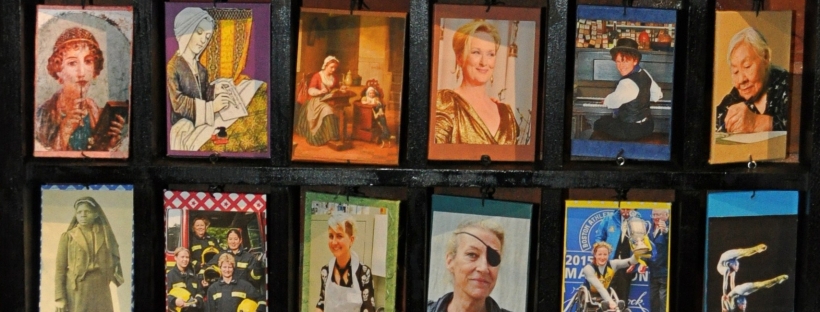Written by Nancer Ballard; ed. assistance Savannah Jackson.
Unlike Heroines’ Journeys, The Hero’s Journey ends with the hero returning to his tribe, kinsmen, country, or home with the Elixir. In Hero Journey stories such as the Lion King, Star Wars, Lord of the Rings, or Wonder Woman, the hero (male, female, or otherwise) finds the treasure, restores his tribe’s lost honor, learns the magic code, or discovers the key to success and is rewarded with recognition, status, and respect.
Maureen Murdock describes the heroine’s quest as an “inner journey toward being a fully integrated, balanced, and whole human being.” Although Murdock focuses on the integration of feminine and masculine personality traits, the heroine’s journey can be understood as a quest to integrate almost any two dichotomies, binaries, opposing concepts, or ideologies. Victoria Schmidt’s version of the heroine’s journey concludes with a “Rebirth– the Moment of Truth” when the protagonist faces her own (and others’) fear with compassion and returns to the “perfect world” or “the world seen for what it is.” The reward for the journey is an integrated connection to the world and something larger than herself.
The Heroine Journeys Project team believes that the Heroine’s Journey is, in essence a search to affirm and experience wholeness. By definition, wholeness necessarily includes both sides of a binary including the masculine and feminine, but also success and failure, perfection and imperfection, joy and grief, happiness and despair, respect and disrespect, glory and stunning disappointment, etc. The world and human experience encompasses each of these things, so respite from disappointment or suffering is temporary so long as life, or the story, continues.

Artist book by Nancer Ballard depicting pleasant and unpleasant aspects of creative cycle
Throughout our lives, most of us are told that loyalty, hard work, sacrifice, and some notion of universal fairness (sometimes called Destiny) will bring us Happiness and Success and eradicate our suffering, frustrations, and disappointment. We are taught that it is possible to “make it,” and become our family/tribe/community leader or win a coveted personal relationship and live happily ever after…. or at least a relatively care-free comfortable life. Many of us know differently but still secretly believe in the mythical hero’s journey arc because we have grown up in a binary-soaked culture and recoil from the unpleasant aspects of wholeness we have been led to believe are unnecessary.
A few months ago I was given a poem by Lynn Ungar (which she has graciously allowed us to share) that describes the kind of stories and lives that royalty and most of us commoners actually live rather than the make-believe myths we think we want to live.
The Story
I’ll tell you a secret.
There is no happy ending.
Also no tragic conclusion.
The prince and princess don’t
live happily ever after.
They live happily sometimes,
and sometimes they are stricken
with so much grief that they know
their hearts will explode—
which never actually happens—
and sometimes they are
well and truly and deeply
bored, and ready for the tiniest
of catastrophes to shake them awake.
They will not, of course,
live ever after. No one does.
But they might have children
who carry on the royal line,
or friends who tell the story
of how the witch showed up
at the baby shower, or maybe
they planted trees. One way
or another the story
inevitably continues.
Pray that it is some kind of
story about love.
In this poem, love is viewed as the best glue for a full evolving life rather than the reward that ends the story-life arc with flatlining good fortune. A good working definition of “love” is an enduring, positive, attentive connection between two (or more) separate beings that creates a relationship. The relationship is distinct and larger than its individual members or constituents. Love does not abolish loneliness and vulnerability, but having a positive, enduring connection with others can make the pain of being alone and being imperfectly understood tolerable. A loving connection also provides company in times of vulnerability.
In Maureen Murdock’s formulation of the Heroine’s Journey, the final step in the cycle is integration. Integration has several meanings. It can refer to the act or an instance of combining disparate elements into an integral whole—as in the integration of personality. But integration can also refer to harmonious behavior of individuals within a larger environment, or to the coordination of distinct previously segregated elements within a unitary system—as in the integration of a school system. In other words, integration can refer to blending or synthesizing or to the coordination of parts in which the parts retain their individual distinctness and integrity within a larger whole. Love draws upon both types of integration. Unless the individuals in a loving relationship maintain their individual selves and identities, the result is a merging of one person into another, or domination and subordination, rather than connection borne by love. Love’s connection also produces a relationship which neither person can create by themselves. Their relationship, a product of their connection to themselves and each other, is a third thing that is something different than the sum of its parts—just as a story depends upon character, action, motivation, and result but is more than the sum of these elements. As in a relationship, each element in a story is necessary and significantly influenced by other elements but can still be somewhat differentiated from the other parts.
Integration of the masculine and feminine, and whatever other binaries are at stake, can involve blending, synthesis, or the coordination of separate elements that retain their individuality within a larger whole. The best stories and fullest of lives involve evolving combinations of each of these.

We appreciate Lynn Unger’s allowing us to share “The Story” in this post. To learn more about Lynn Unger’s work and/or purchase her book of poetry, Bread and Other Miracles, go to http://www.lynnungar.com.

2 thoughts on “Wholeness Introduces Herself to Promises of Happiness and Success”